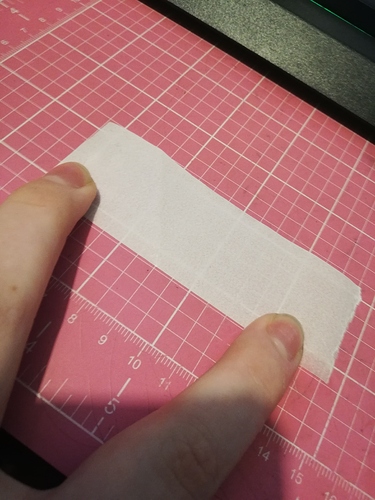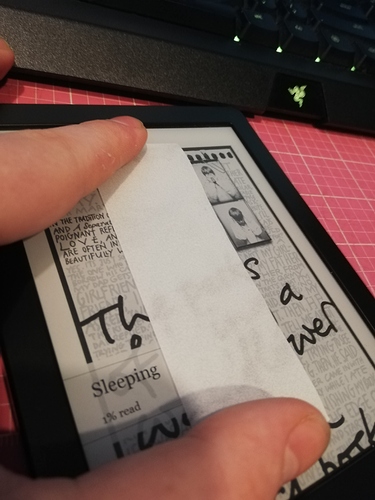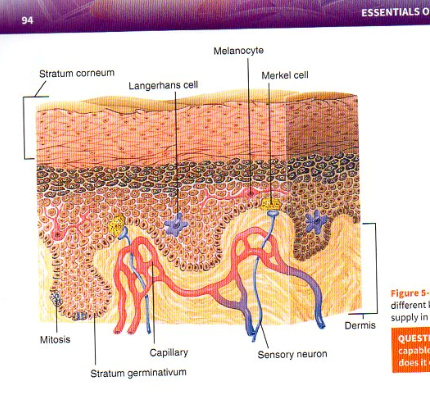![]()
Question on how you will see anything with E-Ink implants? The only reason the E-reader can display anything in lower light is from the side lighting (E-ink can’t be back lit)
I used some really thin wax paper (the stuff NFC stickers come on) and took a control (just on my desk cutting matt) and you can see some of the white come through.
But then taking it and putting it over my e-reader with no lighting on, I used the lightest book cover I had with black writing and it sort of comes through, but really loses almost everything, on top of this I tried it with something slightly less stark and nothing comes through.
Now, this is just with thin wax paper, the concept of installing e-ink would need to be so shallow for the black and white to show through. I could be totally wrong, but I’ve been wondering what yall had thought about that.
As far as I know there hasn’t been any testing on this, but the idea is that the glass microbeads full of electrically charged black and white inks would be suspended in a fluid much like regular tattoo ink, and would be applied the same way. They would be deposited at the dermis-epidermis boundary and then encapsulated by fibroblasts. This would leave the beads very close to the surface, and the ink would be visible when black.
Assuming you could deposit in the dermis, how would you control the e ink? I can’t imagine anything more detailed than say a stylus
New skin cells are generated through mitosis at the stratum germinativum, the bottom of the epidermis. As the skin cells continue to divide, this top layer is pushed further and further up. The cells essentially harden (keratinize) and then die. The dead cells flake off but are continually replaced by keratinizing cells further below.
I believe @vampire_blue’s linked article is the correct answer to this question. It gets trapped in the dermis by macrophages.
This is definitely more complicated and probably above my knowledge level but I’ll give my best guess. Depending on where it landed inside the dermis, I’d say it would either get pushed up or pushed down. At the papillary layer (see above picture) the dermis and stratum germinativum project into each other for the exchange of nutrients. Not to mention the skill level required for someone to land an implant perfectly in the dermis without going beneath. Consider the thinness of the implant in order to be able to place it in that layer. Dermal thickness varies across the body; The skin is very thick on your back, but it is also very thin at the fingertips. Overall, I think the success would depend on the size of your implant and method of implantation.
The macrophages of the skin (Langerhan’s cell above) that were mentioned earlier are perfectly capable of moving between skin cells, but I doubt you want a cellular-sized single pixel of e-ink. You mentioned splinters, and like a splinter I would imagine any foreign body would trigger an inflammatory reaction and try to be pushed out.
My overall answer is: I am not a dermatologist, and I have no fucking clue. Hope this helps.
Your overall answer brings me joy
I think it’s pretty safe to say the dermis / epidermis is a lot more transparent than waxpaper, otherwise you’d never see tattoos clearly.
I am not sure how overlooked that, you are 100% correct
This would also depend on the tone of your skin! My best friend is albino, and she’s basically transluscent. New theory: Albinos have the advantage when it comes to PV cell implants.
That’s true. I have a friend who’s VERY black (like, the blackest skin tone you never saw) and each time he tells me he got a sunburn, I can’t help but laugh my ass off. And each and every time, he gets all serious and pissy, tells me to look closer and I laugh even harder because I really can’t see anything. But he’s adamant it’s visible.
I guess he knows himself better than I do, but whatever subtle change of hue his skin has undergone, it’s not lobster red like mine.
I thought that the genetic evolution regarding skin tone and melanin levels had a lot to do with increased tolerance to the sun, based on the regions of early human evolution
Does he sunburn with equal levels of exposure? Or does he like never wear sunscreen or something?
Interesting, thanks! As a result, I went and wikipedia’ed the hell out of epidermis. Never thought I’d get to know so much about that in my life ![]()
He doesn’t need sunscreen, and he sure as hell doesn’t sunburn easily - he has to really work at it in Belgium, too ![]() I’d look like a cooked lobster at the ER before he’d even start to become uncomfortable. Yet he’s adamant he get sunburns from time to time with enough exposure.
I’d look like a cooked lobster at the ER before he’d even start to become uncomfortable. Yet he’s adamant he get sunburns from time to time with enough exposure.
Actually, if he’s out in the sun, he does - people with darker complexions more commonly get skin cancer from sun exposure, and its often caught far later (i.e. once its started spreading). Sure, they’ll burn a lot slower, but cancer rates are just as high or higher.




